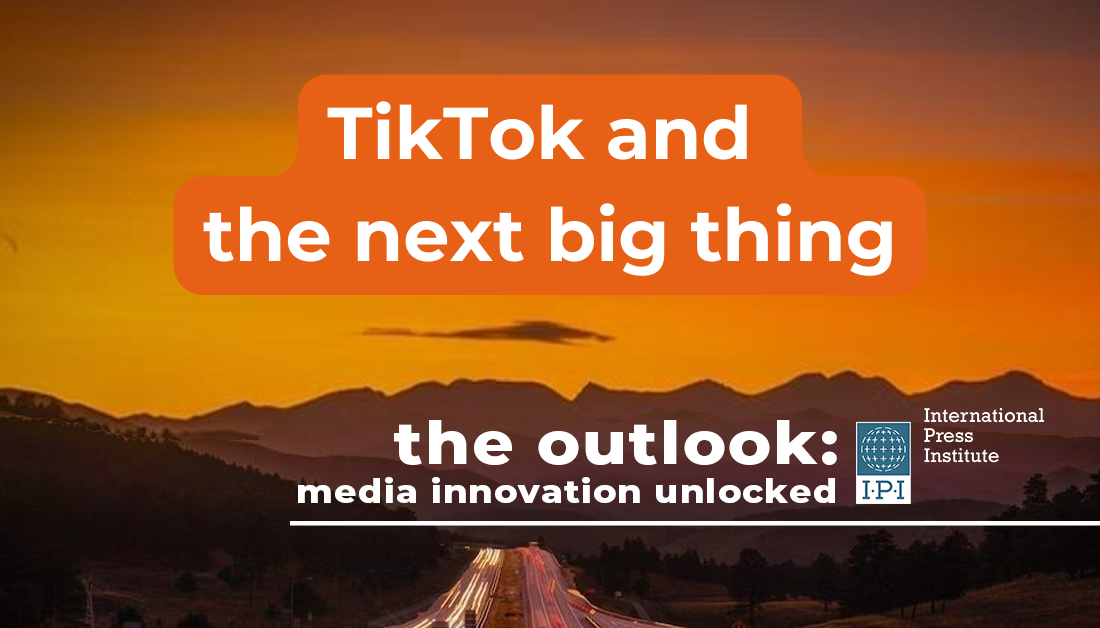This text comes from IPI’s newsletter The Outlook. Click here to sign up to receive future editions direct to your inbox.
This is The Outlook, IPI’s media innovation newsletter, where we take a look at tools and strategies for innovation, and learn from newsrooms that are implementing them. The IPI Media Sustainability Team is fresh from participating in the African Investigative Journalism Conference (AIJC), where it was exciting to meet media managers from across the African continent who work with innovation; more on that later.
In this edition, we’re thinking about how to adapt your storytelling for short-form vertical video.
The challenge: The battle for attention on social media is getting harder
Short-form video is not just about reaching Gen Zs on TikTok – although building reach and engagement with the next generation of news consumers is certainly a worthwhile goal.
The average user’s session on TikTok is over 15 minutes, making it a great place to grab attention. The algorithm and ‘For You’ feed, based on content rather than the accounts that post it, mean that a well-done video which resonates with its audience can get huge reach, no matter how many followers the account has.
On one hand, that’s good news for publishers who are skilled in storytelling and video production. But it also means that news brands’ existing reputation and following won’t automatically boost their views. Journalists compete for audience attention with influencers and creators who know the platforms well.
So the challenge is adapting those skills to tell stories in a way that vertical video consumers appreciate. Again, it’s not just a TikTok question. The changing habits, trends and algorithms that have allowed TikTok to reach 1 billion active users are larger than one platform.
YouTube, Instagram and Facebook all offer short, vertical video formats and video is responsible for a huge share of all web traffic (over 80% according to estimates from Cisco). Adapting to this format is a survival skill for media.
The solution: Get to know the platforms and how your audience uses them
One reason for Spanish TikTok newsroom Ac2ality’s success is that it was set up by members of its target audience. Co-founder Gabriela Campbell told IPI’s Media Innovation Festival this year that she launched the account during the Brexit referendum. Despite reading mainstream media reports on the topic, she felt it hard to grasp the story.
She and her peers wanted quick, clear explanations and topics, so that’s what Ac2ality provides, with one-minute, fast-moving summaries which have made Ac2ality one of Europe’s biggest news accounts on TikTok.
For newsrooms that produce long-form content, vertical video is a way to build reach and kickstart engagement with a certain topic.
Diana Filimon is co-founder of Romanian news site Gen, știri, which combats misinformation. She said: “This is what we want to do: at the end of a TikTok, for them to say ‘ah, I get it now. I will go and look for more [content on the topic].”
Gen, știri significantly boosted their TikTok engagement during IPI’s Transition Accelerator. Through IPI’s network, we were able to link the team with a seasoned coach, Johanna Rüdiger, a TikToker and head of social media strategy at German broadcaster DW, who guided them through the process.
Here’s how they did it:
- First, they assigned ‘ownership’ of Gen, știri’s TikTok work, by creating a team dedicated to the platform.
- They spoke TikTok’s ‘language’: using its inbuilt tools like duets and stitching (ways for users to combine videos) but also other conventions of the platform, for example a clear ‘hook’ to stop users mid-scroll, and lots of short cuts to keep their attention.
- They published regularly, to set expectations. Previous attempts on TikTok had got off to a rocky start after not being able to devote resources to understanding what was working.
- They adapted based on what they learned: trying different things, analyzing how the audience, and responding to their feedback. Note: TikTok is liable to change its algorithm (and audience preferences may evolve!), so this experimentation should be continuous.
As for results, they saw an increase in followers and even more significant increases in comments and shares. These latter two figures were the focus for Gen, știri, because they wanted to build a vibrant community, not just a following.
The direct-to-camera and informal tone of TikTok videos can help to build trust between creators and their community, as do the tools of the platform which encourage engagement.
For both Ac2ality and Gen, știri, over time, these relationships have enabled them to generate revenue though TikTok, through commercial collaborations with brands eager to reach their audiences. For other media outlets, TikTok could be a tool to build awareness and community before nudging followers down a conversion funnel towards subscription or membership.
The Takeaway: Serious news topics belong on any topic where your audience – or potential audience – spends time. The key thing is to know who those people are, and get experimenting to understand their expectations.
Both Ac2ality and Gen, știri have covered topics such as elections and protests on TikTok. Videos still ‘feel’ like TikToks thanks to varied camera angles and lots of visual material, but they use a tone of voice and sound effects appropriate to serious news.
News from IPI’s Media Sustainability Team
IPI’s Ryan Powell, Head of Innovation and Media Business, led a workshop and participated in panels on revenue diversification and journalists’ safety at the the African Investigative Journalism Conference (AIJC). He also introduced IPI’s research project “Sustainability roadmap for media: Discovering and realizing revenue opportunities”, a collaboration with Report for the World.
Stay tuned for more updates on this work, which focuses on product and innovation strategies, how different media types capture user needs, and finally how they identify and pursue revenue opportunities. And if you have any questions, get in touch by clicking ‘reply’.
Next May, the Media Innovation Festival is taking place in Sarajevo. It’s the second year of the festival, and you can catch up on the topics covered last year at IPI’s website, including an insightful TikTok panel featuring Ac2ality and Gen, știri.
Right now the IPI Media Sustainability team is working on putting together the agenda for the festival. We’re open for suggestions on the topics you have burning questions about.
Funding opportunities for media
- Earth Journalism Network grants are open for applications from Asia and the Pacific who have innovative ideas that would strengthen the reach of and audience engagement with environmental reporting. The deadline is December 3 and grants will be between $5,000 and $15,000.
- Ukrainian journalists: N-OST (The Network for Border-Crossing Journalism) invites you to apply for a fellowship that offers grants, participation in two in-person study tours covering six European countries, and the chance to join a network to improve coverage of Ukraine in European media. The deadline is December 11.
- Journalists who write in either English or Spanish can apply for the Michael Jacobs Scholarship which offers $10,000 to fund a book or long-form article about Latin America and/or Spain.
- ICFJ has opened applications for the Health Innovation Journalism Fellowship, including grant funding, training and mentorship, for journalists with at least four years’ experience, including reporting on health-related topics. The deadline is December 15.
- The Obama Foundation Scholars Program is accepting applications for the 2024-2025 program (it’s a nine-month, fully-funded residency at Columbia University), with a deadline of December 12. They’re looking for emerging leaders “who have made meaningful contributions to their field and are now at a “breakthrough moment” in their careers”.
IPI’s media innovation and sustainability work is made possible with support from the European Union, Friedrich Naumann Foundation and ERSTE Foundation.

